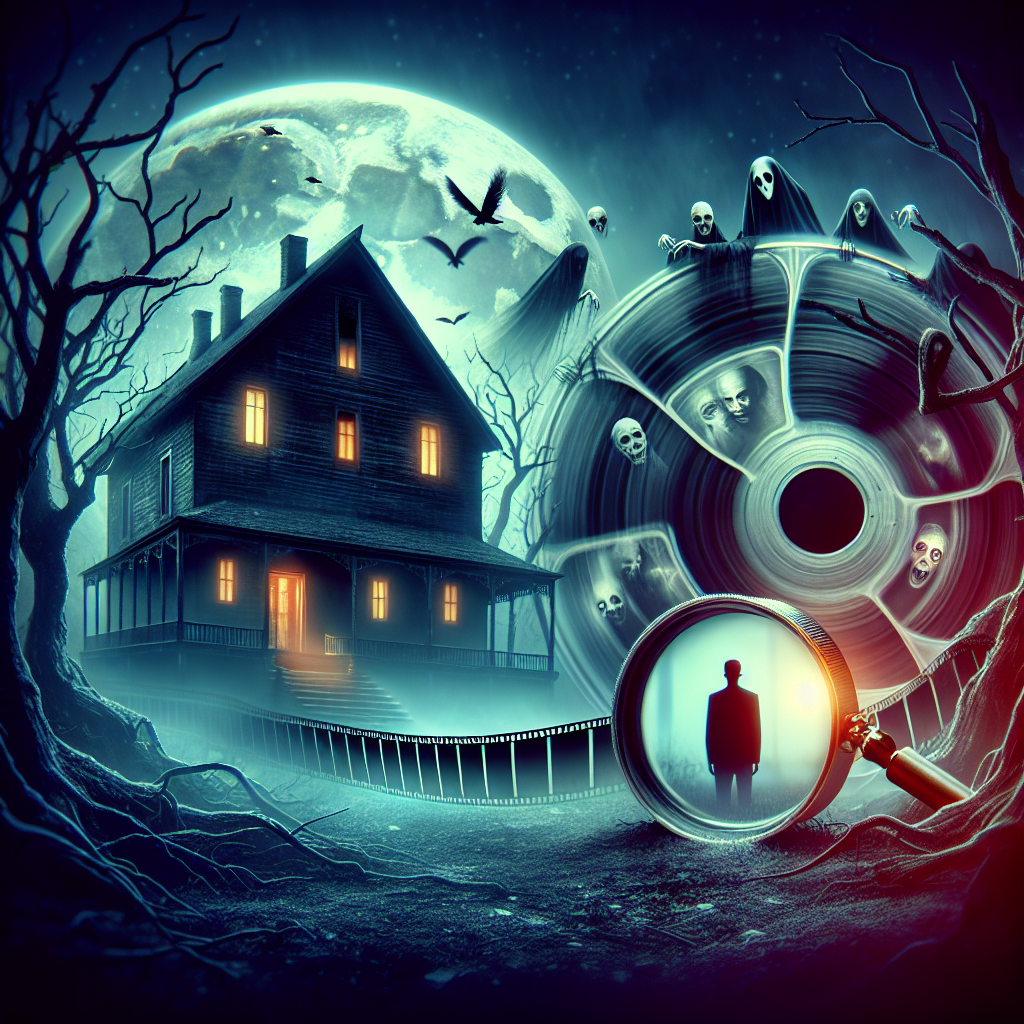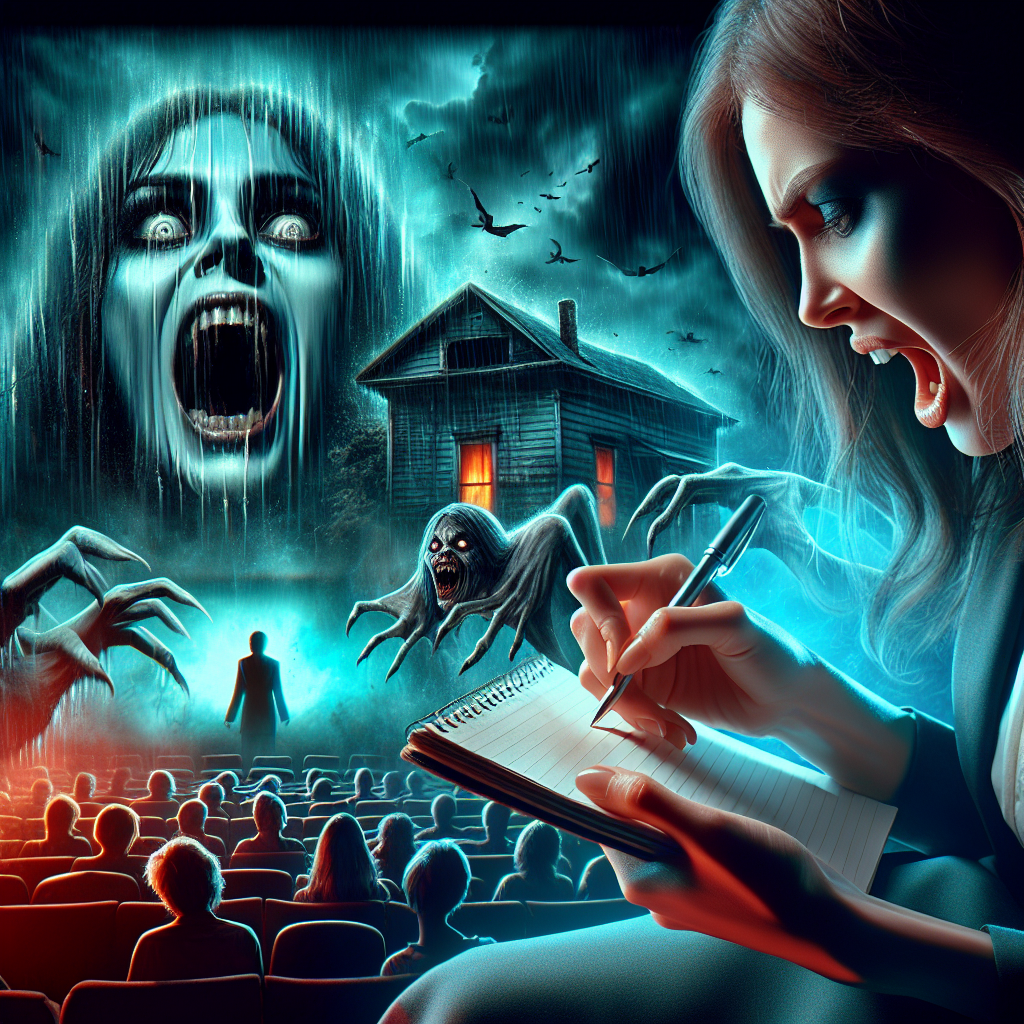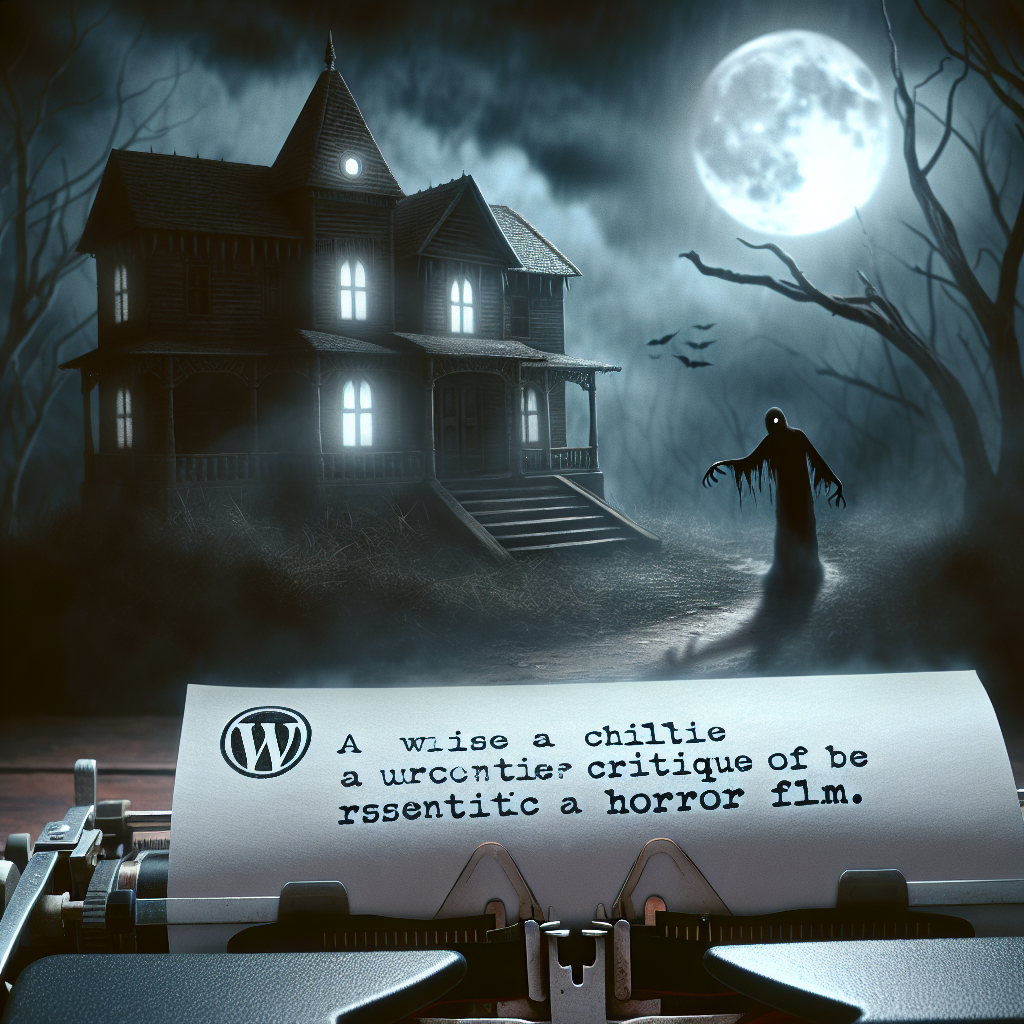In the dark and twisted world of horror films, some critics have dared to confront the most terrifying creations ever to grace the silver screen. Unveiling the Terrifying Truth: Scariest Horror Film Critiques Exposed takes you on a spine-chilling journey through the most bone-chilling and blood-curdling films that have ever haunted our dreams. Discover the heart-pounding reviews that will have you checking under your bed at night and jumping at every creak in the floorboards. From demonic possessions to masked serial killers, this exposé will leave you gasping for breath and sleeping with one eye open. Welcome to a world where fear reigns supreme and the critics hold nothing back.
Analyzing the Top Scariest Horror Films

“The Exorcist” (1973)
- Regarded as one of the most terrifying horror films of all time
- Infamous for its shocking and intense portrayal of demonic possession
- Utilizes unsettling visuals and eerie sound effects to create a sense of dread
- Psychological horror elements deeply disturb viewers long after the movie ends
“The Shining” (1980)
- Directed by Stanley Kubrick, known for his meticulous attention to detail
- Features a haunting atmosphere and slow-building tension
- Jack Nicholson’s performance as the unhinged Jack Torrance adds to the film’s chilling impact
- Overarching themes of isolation and madness contribute to the overall sense of unease
“Hereditary” (2018)
- A modern horror masterpiece that delves into themes of grief and inherited trauma
- Shocking plot twists and disturbing imagery leave audiences in a state of shock
- Toni Collette’s powerhouse performance adds emotional depth to the terror
- Utilizes supernatural elements in a grounded way, making the horror feel uncomfortably close to reality
The Exorcist (1973)
- Exploring the impact of this iconic possession film
The Exorcist, released in 1973, remains a pinnacle in the horror genre, renowned for its spine-tingling portrayal of possession. The film’s depiction of a young girl, Regan MacNeil, possessed by a malevolent entity, captivated audiences worldwide and set a new standard for horror cinema. The chilling scenes of Regan’s transformation and the terrifying manifestations of the demon within her left a lasting impact on viewers, solidifying The Exorcist as a classic in the realm of horror.
- Critiquing the eerie atmosphere and chilling performances
One of the standout elements of The Exorcist is its ability to create an atmosphere of palpable dread and unease. The film’s haunting soundtrack, dimly lit scenes, and ominous cinematography work in harmony to immerse the audience in a world fraught with supernatural terror. Furthermore, the performances delivered by the cast, notably Linda Blair as Regan and Max von Sydow as Father Merrin, are nothing short of exceptional. Blair’s portrayal of the possessed Regan is both harrowing and convincing, while von Sydow brings a gravitas to his role as the experienced exorcist facing off against the forces of evil. Overall, The Exorcist’s ability to instill fear through its atmosphere and performances cements its status as one of the scariest horror films of all time.
The Shining (1980)
-
Stanley Kubrick’s Masterpiece of Psychological Horror: “The Shining” stands as a timeless classic in the horror genre, largely due to Stanley Kubrick’s masterful direction that skillfully blends psychological terror with supernatural elements. The film’s slow-burning tension and eerie atmosphere have cemented its status as a benchmark for horror filmmaking.
-
Unsettling Themes and Haunting Visuals: Within “The Shining,” Kubrick weaves a narrative that explores themes of isolation, madness, and the disintegration of the family unit. As the story unfolds within the confines of the ominous Overlook Hotel, viewers are treated to a visual feast of unsettling imagery, from the iconic hallway of blood to the spectral twins that continue to haunt the audience’s nightmares. The use of space and symmetry in the film’s cinematography adds an additional layer of unease, creating a sense of disorientation and dread that lingers long after the credits roll.
Hereditary (2018)
Analyzing the Top Scariest Horror Films
- Unpacking the modern classic’s slow-burn terror and shocking twists
Hereditary, directed by Ari Aster, is a masterclass in building tension and dread through meticulous pacing and unsettling imagery. The film’s slow-burn approach gradually immerses viewers into a world of escalating horror, where every scene seems to hold a dark secret waiting to be revealed. The shocking twists woven throughout the narrative leave audiences on the edge of their seats, unsure of what terrifying revelation will come next.
- Analyzing the family dynamics and supernatural elements that elevate the fear factor
At the core of Hereditary lies a deeply disturbing exploration of family dynamics and the impact of inherited trauma. The film delves into the complexities of grief, guilt, and the dark secrets that can lurk within a family’s history. The supernatural elements introduced in the story serve to amplify the sense of unease, blurring the lines between psychological terror and otherworldly forces. As the characters grapple with their own demons, both literal and metaphorical, the audience is plunged into a nightmarish descent into madness and despair.

Deconstructing Horror Film Critiques
Understanding the art of critiquing horror films
Critiquing horror films involves delving into the intricate layers of fear-inducing elements that form the backbone of the genre. Critics must possess a deep understanding of psychological triggers, suspense-building techniques, and the manipulation of primal fears to effectively analyze and evaluate a horror film. This goes beyond simple jump scares and gore, requiring a keen eye for subtleties in cinematography, sound design, and narrative construction that contribute to the overall atmosphere of dread and unease.
Examining how critics evaluate scares, storytelling, and originality
Critics assess scares not only based on their shock value but also on their ability to evoke a lasting sense of dread and lingering unease in the audience. Effective scares are those that tap into universal fears and phobias, exploiting them in creative and innovative ways that leave a lasting impact on viewers. Additionally, storytelling plays a crucial role in horror film critiques, with critics evaluating the coherence of plot, character development, and thematic depth in relation to the film’s ability to sustain tension and suspense throughout. Originality is another key aspect that critics look for, as the horror genre is notorious for recycling tropes and clichés; a truly standout horror film will offer a fresh perspective or innovative twist on familiar conventions, setting it apart from the multitude of generic offerings in the genre.
Scare Factor Analysis
- Effectiveness of Jump Scares:
- Jump scares serve as a staple in horror films, designed to startle and evoke immediate fear in viewers.
- The timing and execution of jump scares play a crucial role in maximizing their impact, with sudden appearances or loud noises heightening the scare factor.
-
Overuse of jump scares can desensitize audiences, diminishing their overall effectiveness in creating a sustained sense of dread.
-
Psychological Horror Evaluation:
- Psychological horror delves into the depths of the human psyche, exploiting primal fears and tapping into existential dread.
- Subtle nuances in storytelling, character development, and atmospheric tension contribute to the psychological impact of the film.
-
The most unsettling horror experiences often stem from the manipulation of perception and the blurring of reality, leaving viewers questioning their own sanity.
-
Suspense Building Techniques:
- Suspense is a powerful tool in horror cinema, relying on anticipation and uncertainty to maintain a sense of unease.
- Strategic use of foreshadowing, pacing, and narrative tension keeps audiences on edge, heightening the overall sense of dread.
- Effective suspense building creates a lingering sense of foreboding, instilling a fear that extends beyond the confines of the screen.
Storytelling and Character Development
- Evaluating the importance of a compelling narrative and well-developed characters in horror
In the realm of horror films, a compelling narrative serves as the backbone that keeps viewers engaged and captivated. Without a strong storyline, even the most terrifying visuals and jump scares may fall flat. A well-crafted plot sets the stage for escalating tension, creating a sense of dread that lingers long after the movie ends. It is through the narrative that filmmakers can establish the rules of the supernatural world, build suspense, and deliver satisfying payoffs to audiences.
When it comes to character development, horror films often rely on more than just one-dimensional archetypes to evoke fear. Fleshed-out characters with depth and complexity not only draw viewers into the story but also make their inevitable fates all the more impactful. Audiences become emotionally invested in the characters’ struggles and survival, heightening the stakes of the horror unfolding on screen. Whether through exploring characters’ vulnerabilities, moral dilemmas, or personal traumas, effective character development adds layers of psychological horror to the overall experience.
- Exploring how relatable characters and realistic dialogue enhance the horror experience
Relatable characters act as surrogates for the audience, allowing viewers to project themselves into the terrifying situations depicted in the film. When characters react in ways that feel authentic and believable, it amplifies the sense of realism and immerses audiences deeper into the horror narrative. By establishing a connection with the characters, viewers are more likely to experience genuine fear and anxiety as they witness the unfolding horrors.
Realistic dialogue plays a crucial role in grounding the horror in a sense of authenticity. Conversations that mirror everyday interactions help establish a sense of normalcy before plunging characters into the chaos of supernatural or psychological terror. Well-written dialogue not only serves to advance the plot but also reveals insights into the characters’ personalities, motivations, and fears. When dialogue feels natural and unforced, it enhances the overall atmosphere of the film, making the horror elements all the more chilling and impactful.
Originality and Innovation
- Investigating the impact of unique concepts, twists, and subversions in horror films
In the realm of horror cinema, originality and innovation play pivotal roles in captivating audiences and inducing fear. Unconventional storylines, unexpected plot twists, and narrative subversions often set apart truly terrifying films from the mediocre. When a horror film dares to tread uncharted territory, exploring new themes or presenting unconventional perspectives on traditional horror elements, it has the potential to leave a lasting impression on viewers. By delving into unexplored psychological depths or incorporating fresh mythologies, horror films can challenge societal norms and evoke primal fears in ways that are both unsettling and exhilarating.
- Critiquing the balance between homage to classic tropes and fresh, inventive storytelling
Striking a harmonious balance between paying homage to classic horror tropes and offering innovative storytelling is a delicate tightrope that filmmakers must navigate. While nods to established conventions can evoke nostalgia and provide a sense of comfort for horror enthusiasts, relying too heavily on clichés and predictable plot devices can lead to a lackluster viewing experience. On the other hand, pushing the boundaries of traditional horror norms without a solid foundation in storytelling risks alienating audiences and diluting the impact of the film’s scares. Therefore, the most successful horror films skillfully blend elements of homage with fresh, inventive narratives that subvert expectations and keep viewers on the edge of their seats.
Unmasking Common Misconceptions about Horror Films
-
Horror films are often dismissed as mere entertainment for gore lovers, but in reality, they serve as a unique reflection of societal fears and anxieties.
-
The genre delves into deep-seated human emotions, exploring themes of mortality, the unknown, and the darkness of the human psyche.
-
By tapping into primal fears, horror films provide a cathartic experience for viewers, allowing them to confront their own anxieties in a controlled environment.
-
The assumption that horror films lack artistic merit is a fallacy that fails to acknowledge the creativity and craftsmanship involved in creating a truly terrifying cinematic experience.
-
From innovative storytelling techniques to masterful use of visuals and sound, horror filmmakers often push the boundaries of filmmaking to elicit genuine fear and suspense.
-
Many acclaimed directors have ventured into the horror genre, using it as a platform to explore complex themes and showcase their skills in creating tension and atmosphere.
Horror vs. Gore
- Distinguishing between true horror and excessive gore
- While gore can shock and disgust audiences, it often relies on physical violence rather than psychological manipulation.
- True horror, on the other hand, delves into the depths of human psyche, playing on primal fears and unsettling emotions.
-
The effectiveness of horror lies in its ability to create a sense of dread, anticipation, and unease without solely relying on graphic violence.
-
Highlighting how effective horror relies on atmosphere, tension, and psychological fear
- Atmosphere plays a crucial role in setting the tone of a horror film, creating a sense of foreboding and anticipation.
- Tension builds gradually, keeping audiences on edge and heightening the impact of scares.
- Psychological fear, such as fear of the unknown or fear of the supernatural, lingers long after the movie has ended, haunting viewers in their own minds.
Intellectual Depth in Horror
- Debunking the myth that horror films lack intellectual depth
Horror films are often dismissed as mere sources of cheap thrills and jump scares. However, beneath the surface, these films can possess profound intellectual depth that challenges viewers’ perceptions and provokes thought. By delving into the darkest corners of the human psyche, horror films offer a unique lens through which to explore complex themes and emotions.
- Analyzing how horror can explore complex themes, societal issues, and human psychology

Contrary to popular belief, horror films have the capacity to address a wide range of complex themes, including existential dread, societal anxieties, and the intricacies of human psychology. Through the use of symbolism, allegory, and metaphor, horror filmmakers craft narratives that transcend mere scares, inviting audiences to ponder deeper philosophical questions and confront their deepest fears. The genre’s ability to tap into universal fears and anxieties makes it a powerful tool for exploring the darker aspects of the human experience.
The Evolution of Horror Critiques
- Tracing the transformation of horror film critiques over the decades
A close examination of the evolution of horror film critiques reveals a significant shift in how these films are perceived by critics. In the early days of cinema, horror movies were often dismissed as mere entertainment for the masses, lacking artistic merit or intellectual depth. However, as the genre progressed and filmmakers began to experiment with more complex narratives and innovative techniques, critics started to take notice of the underlying themes and social commentary present in these films.
From exploitation to art: Initially, horror films were seen as exploitative and sensationalist, focusing primarily on shock value and gore to attract audiences. Critics viewed them as lowbrow entertainment, unworthy of serious analysis. However, as directors like Alfred Hitchcock and Roman Polanski began to elevate the genre with psychological horror and suspense-driven narratives, critics started to recognize the artistic merit of these films.
Exploring deeper themes: As horror films began to delve into deeper psychological and societal themes, critics began to analyze them through a more academic lens. Films like “Rosemary’s Baby” and “The Exorcist” tackled issues of gender, religion, and power, prompting critics to reevaluate the genre as a vehicle for social commentary and cultural critique.
- Discussing how the genre has been reevaluated and appreciated by critics
The reevaluation of horror films by critics has led to a newfound appreciation for the genre as a legitimate form of artistic expression. No longer dismissed as mere popcorn fare, horror films are now recognized for their ability to provoke thought, evoke emotions, and reflect the fears and anxieties of society.
Critical acclaim: In recent years, horror films such as “Get Out,” “Hereditary,” and “The Babadook” have received widespread critical acclaim, earning praise for their innovative storytelling, strong performances, and thematic richness. Critics have lauded these films for pushing the boundaries of the genre and challenging audience expectations.
Academic interest: The academic community has also taken notice of the cultural significance of horror films, with many universities now offering courses and conducting research on the genre. Scholars analyze horror films through various theoretical frameworks, exploring concepts such as gender, race, and trauma in relation to these films.
A shift in perspective: The evolution of horror critiques represents a shift in perspective from viewing these films as mere entertainment to recognizing them as complex works of art that offer insight into the human condition. Critics now approach horror films with a greater level of respect and understanding, acknowledging their ability to provoke fear, unease, and introspection in audiences.
From Cult Classics to Critical Acclaim
-
Cult Classics Paving the Way: Initially dismissed as niche or low-budget productions, cult classic horror films have gradually garnered respect and admiration from critics and audiences alike. These films, once relegated to midnight screenings and underground circles, have now become influential in shaping the horror genre’s evolution.
-
Artistic Merit Recognized: The transition from cult status to critical acclaim signifies a broader acknowledgment of the artistic merit embedded within horror cinema. Filmmakers and storytellers within the genre have pushed boundaries, experimenting with themes, visuals, and narratives that challenge conventional norms and provoke thought.
-
Breaking Stereotypes: As critics delve deeper into the layers of horror films, they uncover complexities and nuances that defy stereotypes and preconceived notions. The genre’s ability to explore profound human fears and societal issues through allegory and symbolism has elevated its status from mere shock value entertainment to thought-provoking commentary.
-
Reshaping Perceptions: The journey from cult classics to critical acclaim has reshaped perceptions of horror as a legitimate and valuable form of cinematic expression. Through meticulous analysis and appreciation, these films have transcended their initial categorization, earning recognition for their innovation, storytelling prowess, and cultural impact.
Influential Horror Critics
-
Roger Ebert: Renowned for his insightful critiques, Ebert provided in-depth analyses of horror films that went beyond surface scares. His reviews often delved into the thematic elements and social commentary present in the genre, elevating the discussion around horror cinema.
-
Stephen King: While primarily known as a master of horror fiction, King’s critiques of horror films have also been highly influential. His unique perspective as a creator of terrifying narratives allowed him to offer nuanced insights into the effectiveness of various horror films in eliciting fear and suspense.
-
Robin Wood: A pioneering film critic, Wood’s examination of horror films focused on their subversive potential and psychological underpinnings. His writings challenged conventional interpretations of the genre, pushing audiences to consider the deeper implications of horror beyond mere shock value.
-
Kim Newman: With a vast knowledge of horror cinema history, Newman’s critiques often contextualize contemporary films within the broader lineage of the genre. His analyses highlight the evolution of horror tropes and storytelling techniques, shedding light on the ways in which modern horror films draw inspiration from their predecessors.
FAQs for Unveiling the Terrifying Truth: Scariest Horror Film Critiques Exposed
What makes a horror film truly terrifying according to critiques?
Critiques often highlight various elements that contribute to the scare factor of a horror film. These can include a suspenseful plot, well-developed characters, effective use of sound and visuals, and a chilling atmosphere. Additionally, a successful horror film often leaves a lasting impact on viewers, invoking fear and unease long after the credits roll.
Are there specific horror films that consistently rank as the scariest according to critics?
While opinions on the scariest horror films may vary among critics, some titles have been frequently cited for their ability to terrify audiences. Examples include classics like “The Exorcist,” “Psycho,” and “The Shining,” as well as more recent entries such as “Hereditary,” “Get Out,” and “Paranormal Activity.” These films are praised for their ability to evoke fear through masterful storytelling and suspenseful techniques.
How do horror film critiques approach the portrayal of violence and gore in movies?
Critiques typically consider the portrayal of violence and gore in horror films in terms of its impact on the overall viewing experience. While some critics may appreciate the visceral and shocking nature of intense scenes, others may find excessive violence to be gratuitous and detract from the storytelling. Ultimately, the effectiveness of these elements in a horror film is judged based on their contribution to building tension and atmosphere rather than pure shock value.
Can horror film critiques influence the success of a movie at the box office?
Critiques have the potential to influence audience perception and interest in a horror film, which can impact its box office success. Positive reviews from respected critics can generate buzz and draw in more viewers, leading to increased ticket sales. Conversely, negative critiques may deter potential moviegoers and result in lower box office numbers. However, the success of a horror film ultimately depends on a combination of factors, including marketing, timing of release, and audience preferences.
